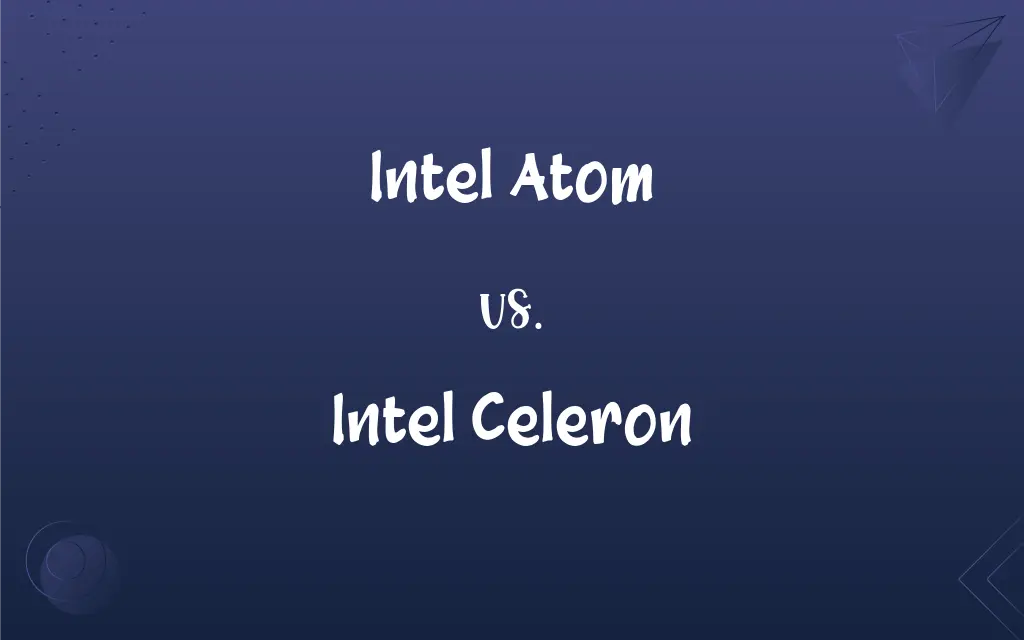Intel Atom vs. Intel Celeron: What's the Difference?
Edited by Aimie Carlson || By Janet White || Published on March 5, 2024
Intel Atom processors are designed for low-power devices, while Intel Celeron processors are aimed at entry-level and budget computing devices.

Key Differences
Intel Atom processors are engineered for energy efficiency and extended battery life, making them ideal for mobile devices and low-power applications. Intel Celeron processors, in contrast, are designed to provide a balance between cost and performance, targeting entry-level PCs and budget laptops. Both Intel Atom and Intel Celeron processors serve distinct market segments, with Atom focusing on minimal power consumption and Celeron emphasizing affordability without significantly compromising performance.
Intel Atom processors typically feature a smaller footprint and lower power consumption, which suits them for tablets, smartphones, and compact embedded systems. Intel Celeron processors, although also used in low-cost laptops and desktops, offer higher computing power, making them suitable for basic computing tasks such as web browsing, office applications, and light multimedia activities. The difference in architecture and target application areas between Intel Atom and Intel Celeron processors underscores Intel's strategy to cater to a wide range of computing needs.
In terms of performance, Intel Atom processors are optimized for tasks that require minimal processing power, ensuring devices remain energy-efficient and cool. Intel Celeron processors, while not high-end, are capable of handling more demanding tasks than Atom processors, thanks to their higher clock speeds and greater cache sizes. This makes Celeron-equipped devices more versatile, capable of supporting a broader range of everyday computing activities.
Intel Atom processors are often found in devices where space and power are at a premium, such as in IoT devices and portable electronics. Intel Celeron processors are more commonly found in budget-friendly laptops and desktops that require more traditional computing capabilities. The distinct design philosophies of Intel Atom and Intel Celeron processors reflect Intel's approach to serving both the ultra-low-power and the budget-conscious segments of the computing market.
Despite their differences, both Intel Atom and Intel Celeron processors share Intel's commitment to reliability and support for basic computing functionalities. Whether optimizing for power efficiency in an Intel Atom-powered device or seeking affordability in a Celeron-based system, users can expect a level of performance that aligns with Intel's standards. The choice between an Intel Atom and an Intel Celeron processor ultimately depends on the specific needs and constraints of the user or application.
ADVERTISEMENT
Comparison Chart
Design Focus
Energy efficiency and extended battery life
Balance between cost and performance
Typical Use Cases
Mobile devices, tablets, IoT devices
Entry-level PCs, budget laptops
Power Consumption
Lower, optimized for minimal power draw
Higher, but still designed for efficiency
Performance
Suitable for basic tasks, optimized for low power
Suitable for a broader range of computing tasks
Market Segment
Ultra-low-power devices
Budget-conscious, entry-level computing devices
ADVERTISEMENT
Intel Atom and Intel Celeron Definitions
Intel Atom
Intel Atom processors are used in compact and mobile devices due to their small size and efficiency.
The IoT device is powered by an Intel Atom processor for its compact size and energy efficiency.
Intel Celeron
Intel Celeron processors are aimed at providing affordable computing solutions.
The budget laptop is equipped with an Intel Celeron processor to keep costs down.
Intel Atom
Intel Atom processors support basic computing tasks with minimal power consumption.
The entry-level smartphone uses an Intel Atom processor to optimize power usage.
Intel Celeron
Intel Celeron processors balance cost with sufficient performance for everyday tasks.
The Intel Celeron processor in our home PC handles all our web browsing and document editing needs.
Intel Atom
Intel Atom processors contribute to the extended battery life of portable devices.
Thanks to the Intel Atom processor, the e-reader boasts weeks of battery life.
Intel Celeron
Intel Celeron processors are suitable for entry-level PCs and laptops.
The school's computer lab is outfitted with Intel Celeron-based desktops for educational purposes.
Intel Atom
Intel Atom processors are designed for ultra-low-power devices.
The Intel Atom processor enables the tablet to have a long battery life.
Intel Celeron
Intel Celeron processors are found in budget-friendly computing devices.
For those on a tight budget, a tablet with an Intel Celeron processor is a good choice.
Intel Atom
Intel Atom processors are ideal for embedded systems and portable electronics.
The wearable device uses an Intel Atom processor to maintain its lightweight and long-lasting performance.
Intel Celeron
Intel Celeron processors offer reliable performance for basic computing applications.
The Intel Celeron processor ensures smooth performance for the family's entry-level all-in-one computer.
FAQs
How do Intel Atom processors differ from Intel Celeron in power consumption?
Intel Atom processors have lower power consumption, while Celeron processors consume more power but offer higher performance.
What is an Intel Celeron processor?
An Intel Celeron processor targets entry-level and budget computing devices, balancing cost and performance.
Can Intel Atom processors handle intensive computing tasks?
Intel Atom processors are optimized for basic tasks and energy efficiency, not for intensive computing.
Are Intel Celeron processors good for gaming?
Intel Celeron processors can handle some light gaming, but they're not designed for high-end gaming experiences.
Are Intel Celeron processors found in laptops?
Yes, Intel Celeron processors are often found in budget and entry-level laptops.
How does the performance of Intel Celeron processors compare to high-end processors?
Intel Celeron processors have lower performance compared to high-end processors, reflecting their budget-friendly nature.
What devices typically use Intel Atom processors?
Intel Atom processors are commonly used in mobile devices, tablets, and IoT devices.
What is an Intel Atom processor?
An Intel Atom processor is designed for ultra-low-power devices, focusing on energy efficiency.
Are Intel Atom processors suitable for smartphones?
Intel Atom processors have been used in smartphones, especially where long battery life is a priority.
What advancements have been made in recent Intel Atom processors?
Recent Intel Atom processors have seen improvements in energy efficiency and performance, catering to the evolving needs of portable and embedded devices.
Can Intel Celeron processors be used in servers?
Intel Celeron processors are not typically used in servers; they're more suited to consumer-level computing devices.
Can I use an Intel Celeron processor for office work?
Yes, Intel Celeron processors are suitable for basic office work like document editing and web browsing.
Do Intel Atom processors support Windows operating systems?
Yes, Intel Atom processors can support Windows operating systems, but they're optimized for lighter versions and tasks.
How do Intel Atom processors contribute to battery life?
Intel Atom processors contribute to extended battery life due to their low power consumption.
What is the role of Intel Atom processors in IoT devices?
Intel Atom processors power IoT devices by providing efficient processing capabilities with minimal power consumption.
How do Intel Atom and Intel Celeron processors compare in terms of price?
Both are aimed at budget-conscious markets, but Atom processors are typically found in lower-cost devices than Celeron.
Can Intel Atom processors be used in desktop computers?
While possible, Intel Atom processors are more commonly used in mobile and compact devices rather than desktops.
What makes Intel Celeron processors a popular choice for educational institutions?
Their affordability and adequate performance for basic tasks make Intel Celeron processors popular in educational settings.
Do Intel Atom processors support 4K video playback?
Some newer Intel Atom processors might support 4K video playback, but they're generally not optimized for high-resolution video.
Can Intel Celeron processors handle multitasking?
Intel Celeron processors can handle basic multitasking but might struggle with intensive multitasking demands.
About Author
Written by
Janet WhiteJanet White has been an esteemed writer and blogger for Difference Wiki. Holding a Master's degree in Science and Medical Journalism from the prestigious Boston University, she has consistently demonstrated her expertise and passion for her field. When she's not immersed in her work, Janet relishes her time exercising, delving into a good book, and cherishing moments with friends and family.
Edited by
Aimie CarlsonAimie Carlson, holding a master's degree in English literature, is a fervent English language enthusiast. She lends her writing talents to Difference Wiki, a prominent website that specializes in comparisons, offering readers insightful analyses that both captivate and inform.































































